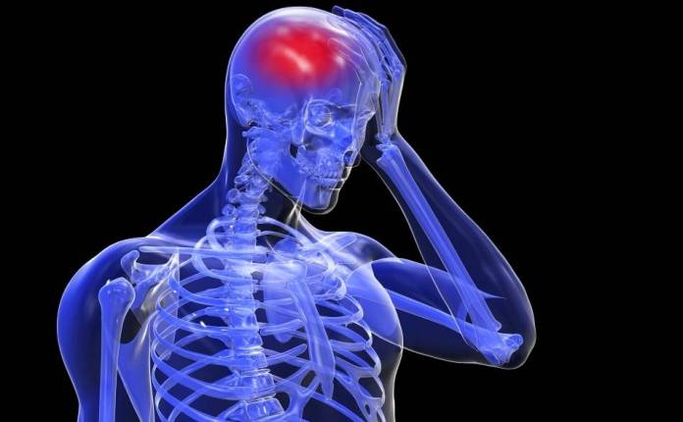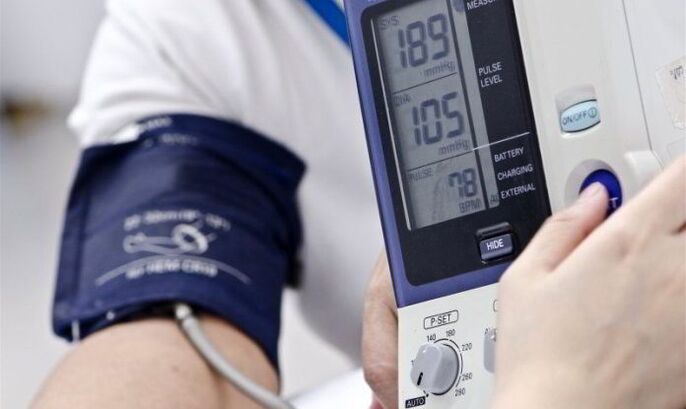Cervical osteochondrosis is a spinal disease, characterized by disorders of intervertebral discs.Pathology is characterized by the elderly, but a person of any age can cope with it.Tangible discomfort causes one of the main signs of this disease - severe pain.The patient needs to know that the cervical osteochondrosis is dangerous and what problems he will face.
Nuances of the disease
The cervical region is one of the most mobile parts of the body, and it withstands regular loads.With the development of osteochondrosis, the vertebral shift, which leads to compression of many vessels and veins.The main complexity of pathology is that its characteristic diastrophic changes affect the roots of the spinal nerve and intervertebral space.Because of this, the brain lives without essential oxygen, blood supply is lost.

In the risk area, there are mainly elderly people in which the disease develops against the background of metabolic disorders, and changes in the composition of vertebrae and intervertebral discs are age -related.The development of such violations can also be the reason:
- Salt deposition;
- Inadequate physical activity;
- Inappropriate nutrition;
- Injuries;
- Frequent hypothermia;
- Hormone problems;
- Additional weight;
- Older diseases.
Osteochondrosis also provokes a long -lengthy appearance of the body in a condition, which puts office staff and drivers under blowing.
Symptoms of osteochondrosis
In the initial stage of the disease, symptoms are almost invisible, anxiety can only cause mild pain in the neck.But as the pathology develops, the symptoms are gradually increasing.
Osteochondrosis of the cervical spine can be identified by the following signs:
- Severe pain in the neck, nap, shoulders;
- Regular migraine;
- Hand weakness;
- Neck mobility is limited;
- When beating the head, the vertebral crunch is performed;
- hearing problems;
- A characteristic ring appears in the ears;
- Throat discomfort.
In the early stages, pain syndrome manifests only during movement, when bending or turning the neck.Over time, the pain also occurs when the condition of the hands changes.
Potential complications
If cervical osteochondrosis is not treated, degenerative processes on the intervertebral disc will cause loss and density of their main functions.Excessive dynamics of the spine will gradually develop, there will be damage to muscles, joints and ligaments.The pressure on the nerve endings and spinal cord will only intensify, which will increase the symptoms and promote the development of new pathological phenomena.

Frequent migraine
For the most common results of osteochondrosis of the cervical spine, you can calculate a headache.This is because it is on this site that the vertebral artery is located, which is responsible for the distribution of oxygen and blood to the brain.
As the disk strength changes, the refinement works are violated.Press on deformed vertebral artery, intervention with blood circulation and "distribution" of essential oxygen.Muscle cramps are developing.
After pain, concomitant symptoms often follow:
- nausea;
- Vomit;
- Fast increase in pressure;
- Tingling in shoulder blades;
- Weakness throughout the body.
With serious attacks, it is desirable to relax as much as possible, it is better in a horizontal situation.An unpleasant syndrome can remove pain relievers or cold compresses, while the massage is useless.
Problems with vision
Complications of cervical cervical osteochondrosis often affect the organs of vision: This section of the spine contains sleep and vertebral arteries, which are responsible for blood flow to the visual central structure.Compression of nerve roots and blood vessels causes hypoxia and causes vision decrease.
Simultaneous symptoms along with syndrome of vertebrae artery:
- Fog;
- Being black in the eyes;
- The presence of "flies" or colored spots;
- Different;
- Excessive stress of optic nerve;
- Dizziness;
- nausea.

During the examination, an expert may notice a narrowness of the eye retina arterial vessels, less frequently inflammation of the optic nerves.In addition, against the background of the disease, glaucoma may appear, as well as with introcular pressure and pain.
hearing problems
Due to compression of vertebral artery and nerve roots, hearing loss is possible up to 20–30%.Nequar osteochondrosis can also cause completely deafness.To avoid this, you should contact a doctor on the first symptoms of the disease.
Slight decrease in hearing is reversible: In addition to drug treatment prescribed by a doctor, the patient requires special exercise or massage of ear shells.Watching TV or listening to music is better in small amounts to stress the organs of hearing.
Hypotension
Low or increased blood pressure is quite common consequences of osteochondrosis of the cervix.The biggest danger is high blood pressure, which are characteristic:
- Opery of pulse;
- Increase in sensitivity to temperature;
- Sleep disturbances;
- Nasal bleeding;
- Dispenser;
- heart pain;
- Sweat
The higher the blood pressure, the more load falls on the heart, which leads to its rapid wear.As a result, heart failure develops.In hypertension, atherosclerosis develops rapidly, which is dangerous with brain strokes.
Hypotenia does not pose a direct threat to life, but greatly affects its quality.The body experiences oxygen starvation, which affects the patient's normal well.Hypotonia is characterized by a violation of venous and arterial blood supply, and it increases disturbances in the sensitivity of the organs.Possible complications are myocardial infarction.

Vegetable -Destinia
Vegets -Avskular Dystonia is a common designation of syndrome, which can affect many body systems and organs.Most of the pathology, the cardiovascular system and peripheral nerves suffer from pathology.The patient experiences constant anxiety and rapid emotional difference.Frequent panic attacks are also possible, and the heart rhythm becomes more frequent.
Symptoms of diastonia can be lubricated or disguised as other diseases.In this case the results of osteochondrosis of the cervical region are also not the most pleasant.So, the gastrointestinal tract often suffers: nausea and vomiting, diarrhea, constipation and severe abdominal pain are possible.The gallbladder or liver disorders are possible.Patients often complain of tachycardia, pressure problem and heartache.
Contradiction
With an intervertebral hernia, the disk pieces have "protruding" in the spinal canal or fall out.The initial stage of this pathology is called Falav.The integrity of the intervertebral disc is not disturbed with it, but the spinal canal has a slight bones.At this stage, pressure on spinal roots, so the main symptom is weak pain that occurs during movement.In later stages, pain syndrome is increased.
The dynamics of the vertebrae gradually decreases.The muscle tension is increased, even if the patient is in a relaxed position.You can also note periodic weakness in the upper parts of the hands or in the wrist.Numbness of hands appears, and a tingling tinge is often near the thumb.
This is the one that is the dangerous osteochondrosis of the cervical spine with hernia: it has a serious load on the artery, which passes next to the vertebral column and is required to supply the right blood to the brain.If there is excessive pressure of the patient, ischemic stroke may be expected.
A large hernia is dangerous for inflammation of the surrounding ligaments - it is filled with cervical radiculitis.Only timely treatment can prevent complications.The patient needs to listen to his body carefully and consult a doctor on the first symptoms.The reason for doubt should be:
- Fast attacks without nausea without any visual cause;
- Black in the eyes while walking;
- Noise in the ears when folding the head;
- Draw sensations into the neck with long stay in a standing position.
The most severe complications are the risk of irreversible paralysis of one or both hands.Cerebral nerve atrophy leads to this, which is located in the cervical region.If the hernia starts putting pressure on the blood vessels, they will die slowly, which will increase the number of many organs.
Vestibular-barrel syndrome
The vestibular-barrel syndrome is a condition in which the patient experiences a strong dizziness that occurs with the loss of orientation.
The attacks arise with rapid growth, faster or throw back the head.State Specialty:
- Noise in the ears;
- nausea;
- visual impairment;
- To feel that everything is moving in front of his eyes and swimming.
The main cause of pathology is the lack of blood supply, which increased the dysfunction of the vestibular system.The syndrome will be more and more often because osteochondrosis develops.
Fantastic minute syndrome
The osteochondrosis launched is dangerous with neuro-conventional disorders of the throat and vyantra.Characterized by syndrome:
- Loresness;
- Difficulties when swallowing;
- Continuous sensation of a coma in the throat;
- Dryness and agony;
- Full loss of voice.
The syndrome occurs suddenly and is accompanied by dizziness.
Syndrome bar leu
Another name for pathology is the syndrome of the vertebral artery.The reason for its development is the stanosis (narrow) of the vertebral canal, which contains spasms of the vertebral artery and compression of blood vessels and veins.
Symptoms include:
- high blood pressure;
- nausea;
- Tachycardia;
- Carving in the eyes;
- Noise in the ears;
- Loss of coordination of movements;
- Pulling pain in temples or posterior region.
With a sharp movement or turning the neck, the patient may lose consciousness.

Hypotolamic syndrome
At the same time, hypothalamus is prone to syndrome - a part of the brain that is responsible for metabolism, pressure, sleep, body temperature and emotional reactions of a person.Functional disorders can be revealed by increasing or weakening the activity of the brain department.In the first case, the patient becomes irritable, in the second - interrupted.
Symptoms often resemble neuroshania, which reveals themselves:
- Sleep disorder;
- Anger;
- Irritability;
- High fatigue;
- Mood instability.
A person loses the opportunity to focus, there are problems with remembering.Improper outbreaks of anger are possible, hunger disappears, libido decreases.
Better than treating any disease, it is quite difficult to predict the behavior of osteochondrosis.If there are risk factor, you need to set a set of simple physical exercises regularly that will increase the dynamics of the vertebrae and eliminate the congestion in the collar area.
The frequent presence of any described symptoms is a clear indication of the body that about the problems occurring in it.At the same time, self -naming is useless, and it will not work without consulting a specialist.



















































